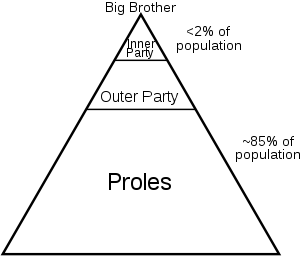Inner Party
In the dystopian world of George Orwell's 1949 novel Nineteen Eighty-Four, Oceania is split into three "classes": the Inner Party; the Outer Party (the lower bureaucracy);[1] and the proles.[2] The Party is the privileged upper ruling class that makes up just 2% of the total population.[3]

The Inner Party generally regulates Ingsoc (English Socialism)[4] and the Thought Police, and keep all Outer Party members under close supervision through telescreens and cameras, while the proles live in depressed (but unmonitored) conditions.
Living conditions
The Inner Party represents the oligarchical political class in Oceania, it is the first ruling class in history dispensing with ideology .[5] It is generally represented by Big Brother. Inner Party members enjoy a quality of life that is much better than that of the Outer Party members and the proles. The telescreens in their homes can ostensibly be turned off indefinitely (although O'Brien tells Winston and Julia it is unwise to turn it off more than 30 minutes at a time). This revelation might, however, be a lie to Winston and Julia, in that conversations they had after O'Brien supposedly turned off his telescreen were later played back to them anyway. A more likely explanation is that Inner Party members do have the ability to turn off their telescreens, but O'Brien simply chose not to for the purpose of exposing Winston and Julia as dissidents.
Inner Party members have access to spacious living quarters, personal servants, private motor vehicles (motor vehicles are very heavily restricted and not allowed to Outer Party or Proles), and high quality food, drink, and consumer goods, in contrast to the low quality gin, (mostly) synthetic coffee, and improperly manufactured cigarettes consumed by the Outer Party and the Proles. Inner Party members have access to wine, as well as real coffee, tea, sugar, milk, and well-made cigarettes. Inner Party neighbourhoods are kept clean and presentable, compared to Outer Party and Prole neighbourhoods.
Prospective members of the Inner Party are selected at a young age according to a series of tests; racial origin and family heritage are of no importance in this process as long as their loyalty is proven. Goldstein's book states that a child born to Inner Party parents is not automatically born into the Inner Party, and that all racial groups in Oceania, including "Jews, negroes, and South Americans of pure Indian blood" are represented in the ranks. Visually, Inner Party members are always identifiable in public by their black jumpsuits. No Outer Party member or Prole may venture into Inner Party neighbourhoods without permission from an Inner Party member.
In the novel, O'Brien is the only character Winston meets who is a member of the Inner Party.
Goldstein's book explains the rationale behind the class divisions in Oceania, but the book is found to have been made by an Inner Party committee of which O'Brien was a part.
See also
References
- The New International; a Monthly Organ of Revolutionary Marxism. 1950. p. 363.–from University of California.
- "How 2016 is turning into George Orwell's '1984'". Daily Kos. 11 December 2016.
- "Inner Party in 1984". study.com. 21 July 2007.
- Joshua Philipp"'Thoughtcrime' Is Becoming a Reality". The Epoch Times. May 19, 2019.
- "George Orwell's "1984"". Alliance for Workers' Liberty. 5 August 2013.
Bibliography
External links